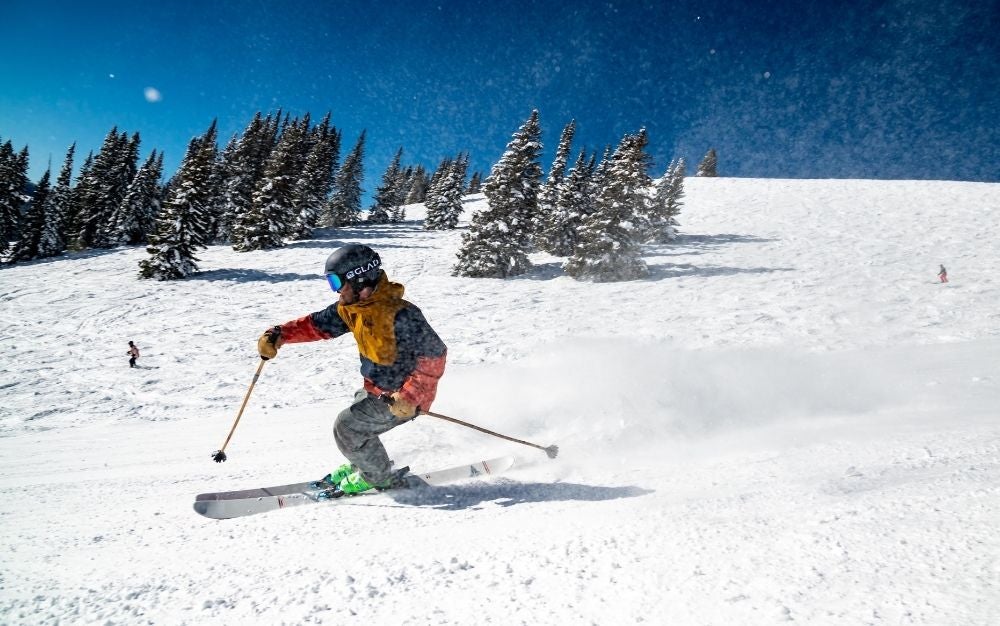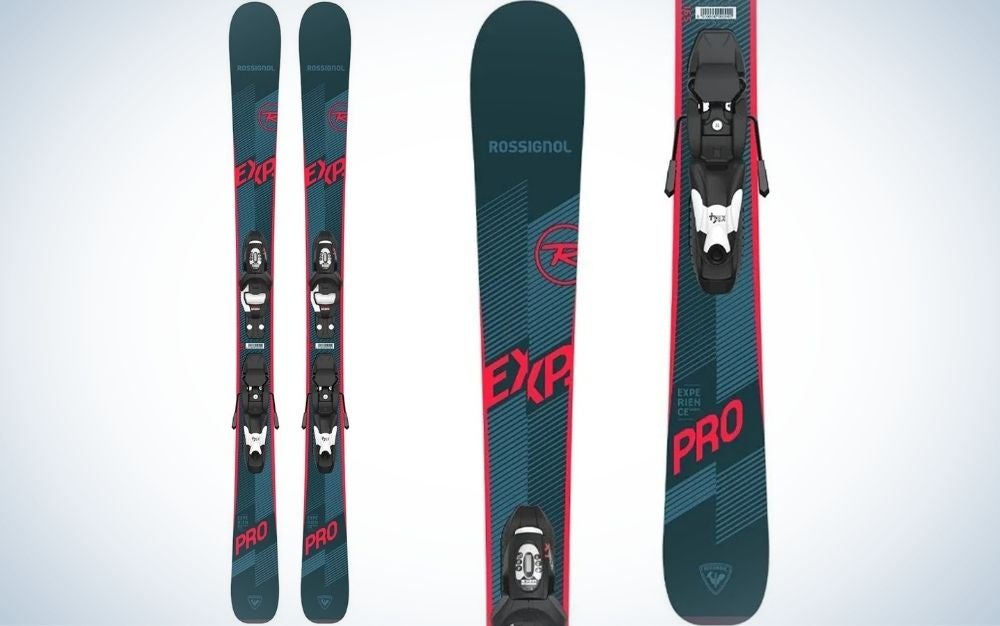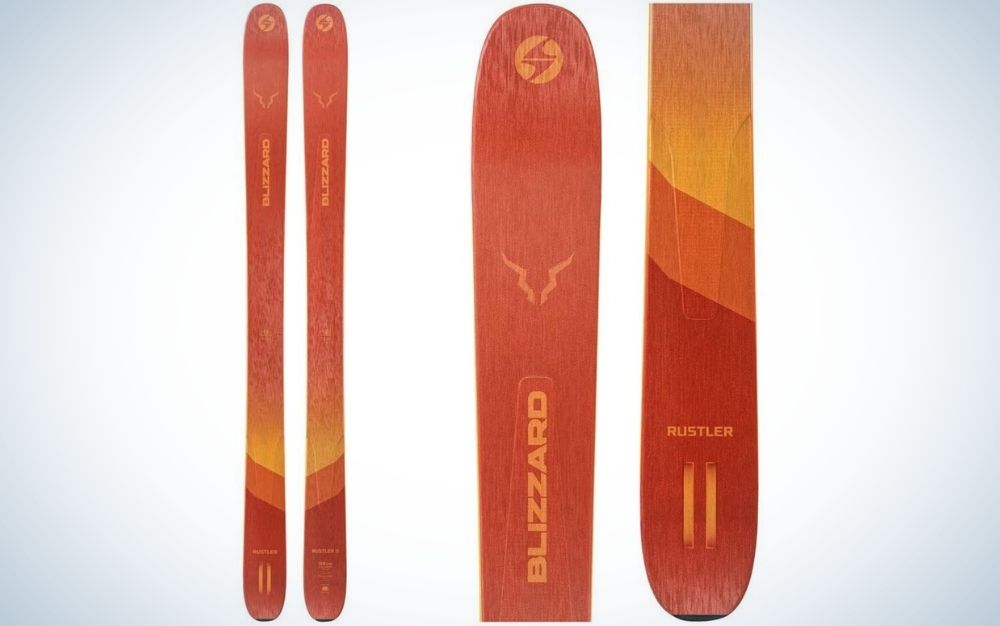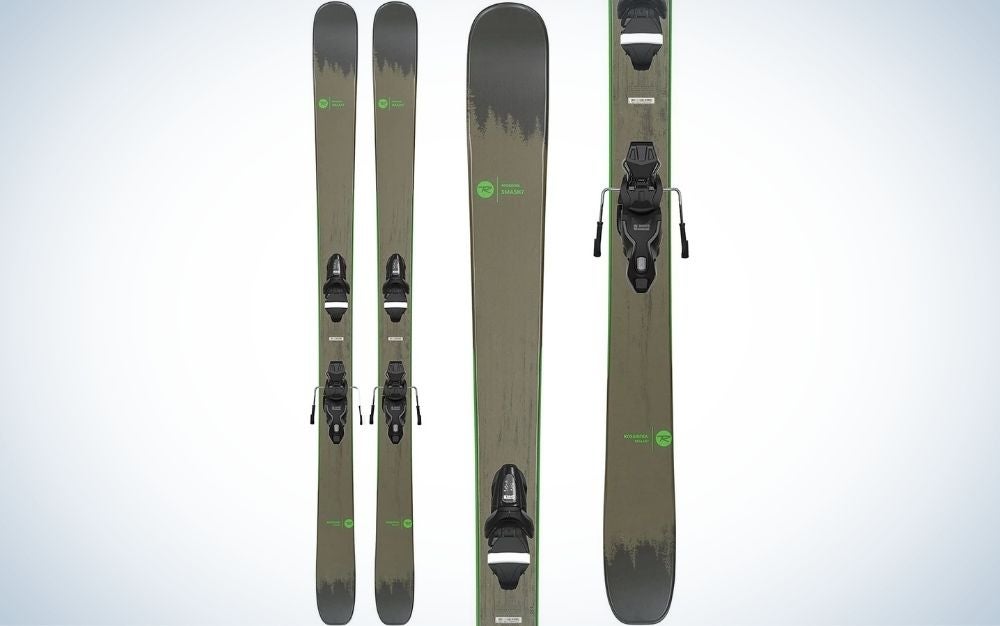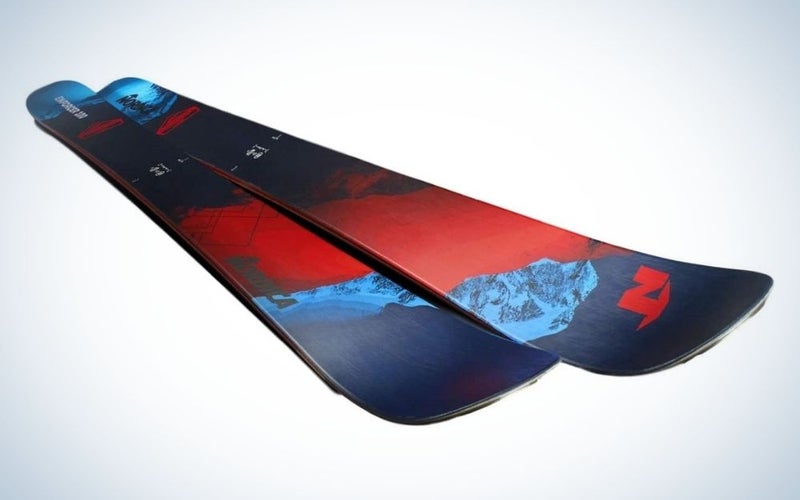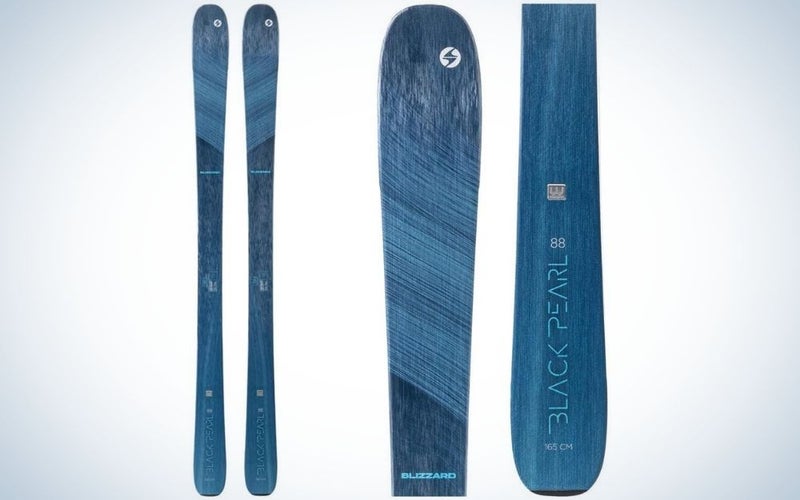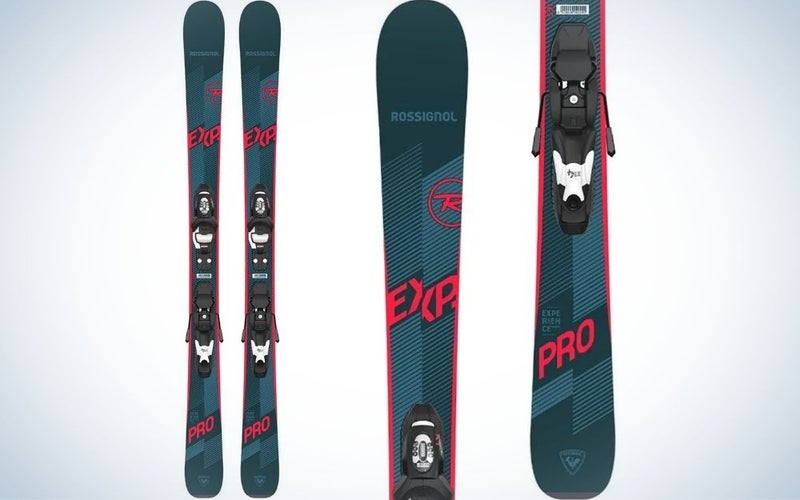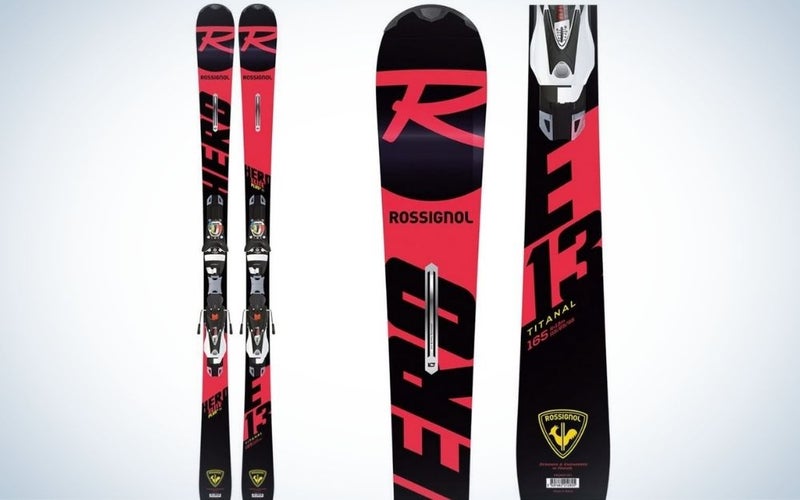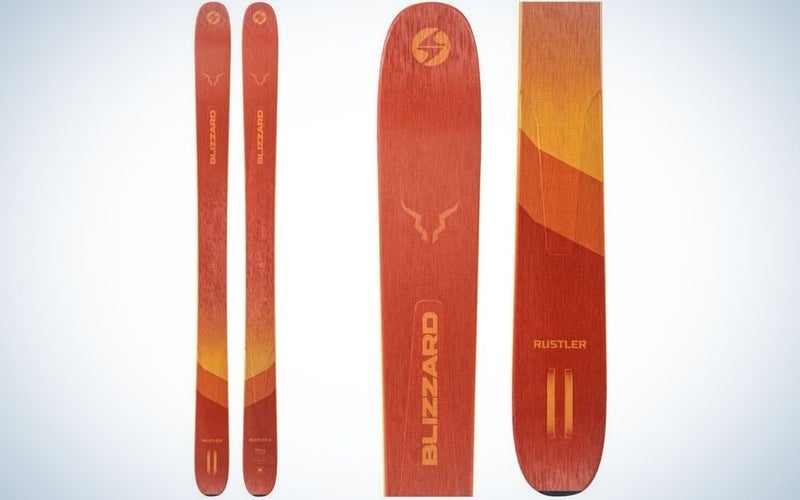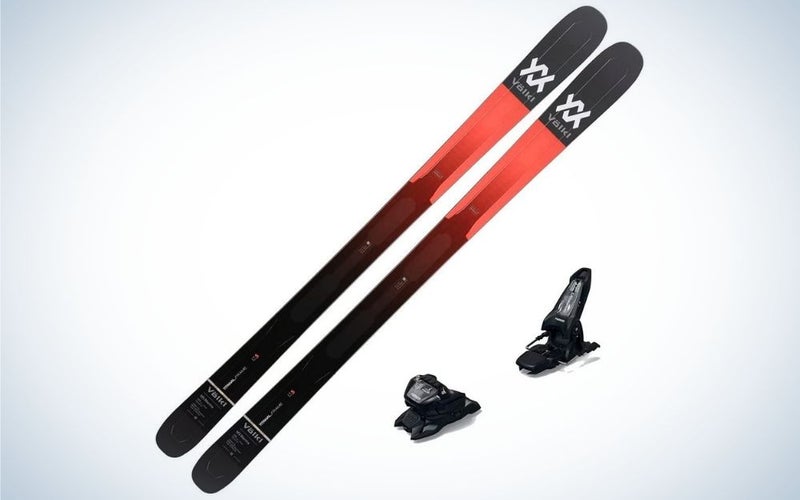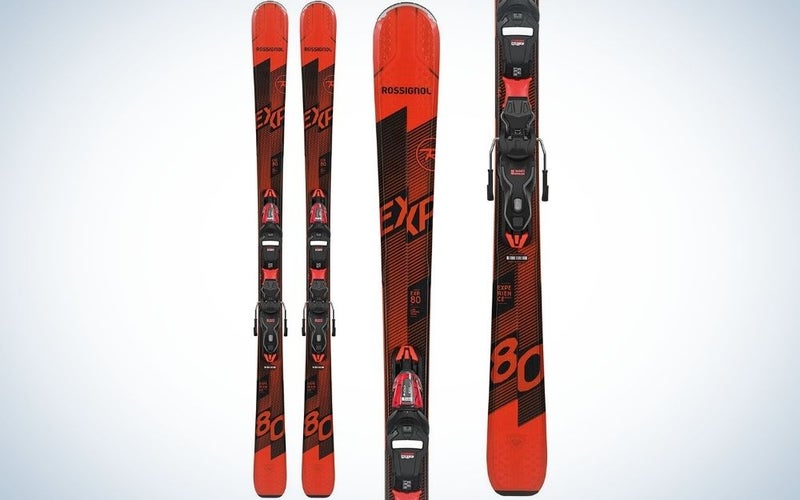We may earn revenue from the products available on this page and participate in affiliate programs. Learn more ›
The thrill of hitting the powder makes it hard to resist the call of the slopes. When you’re making those turns on the best downhill skis, you merge with the slopes and become part of a centuries-long tradition. Snow skis have come a long way since the days of strapping wooden boards to the feet and tromping through the snow. Today, different types of skis cater to different ski styles—the carvers and mogul junkies—and conditions—crud, ice, and powder.
Do you attack the mountain, or do you float above the snow, gliding where the mountain takes you? The skis’ materials, shape, edge design, and weight change how they feel and respond. Consequently, if icy conditions rule your local mountain, you’ll need different skis than if a fresh layer of powder welcomes you on the weekends. Keep reading to get the lowdown on the best downhill skis for the wide range of factors you bring to or run into on the mountain.
- Best men’s ski: Nordica Enforcer 100 Skis
- Best women’s ski: BLIZZARD Women’s Black Pearl 88 All-Mountain Skis
- Best beginner ski for kids: Rossignol Experience Pro Skis
- Best downhill ski for groomed runs: Rossignol Hero Elite Plus Ti Skis
- Best powder skis: Blizzard Rustler 11 Skis
- Best all-mountain skis: Volkl M6 Mantra Men’s Skis
- Best for moguls: Rossignol Experience 80 CA Mens Skis
The best downhill skis: Reviews & Recommendations
Best men’s skis: Nordica Enforcer 100 Skis
Nordica
The Nordica 2022 Enforcer 100 Skis feature a carbon-reinforced wood core surrounded by two metal sheets. The carbon fiber reduces the overall weight but gives the ski more strength and responsiveness. The combination of materials, length, and width makes it an excellent choice for powder or groomed runs. Nordica has adjusted the core thickness with each length, creating greater stability at shorter lengths.
Best women’s skis: BLIZZARD Women’s Black Pearl 88 All-Mountain Skis
Blizzard Entertainment
A narrower waist and carbon flipcore design give the BLIZZARD Black Pearl 88 excellent stability, especially if you keep your speed entering into the turn. The edges dig into the mountain, making it a better choice for those who prefer carving into groomed runs than riding through the powder. However, it can also handle powder to a depth of about six inches. Overall, it’s a stable choice that lets a woman carve deep trenches all the way down the mountain.
Best beginner ski for kids: Rossignol Experience Pro Skis
Rossignol
Rossignol Experience Pro Skis have the materials and design for intermediate junior skiers who are ready to carve or float down the mountain. A medium-width waist keeps it from sinking too deeply into the powder, but the edge provides the cut to stay in control on groomed snow. The flex and rocker support young skiers as they develop their ability to turn, pivot, and stop.
Best for groomed runs: Rossignol Hero Elite Plus Ti Skis
Rossignol
The Rossignol Hero Elite Plus Ti Skis integrate technology from the company’s race line. The Line Control Technology locks the ski into each turn, letting you dig into the mountain as you carve your line. A narrower waist creates quick turns that let you take on a diverse range of run difficulties, including the elusive double black diamonds.
Best powder skis: Blizzard Rustler 11 Skis
Blizzard Entertainment
The Blizzard Rustler 11 Skis definitely do not have a trim waist. The wide width gives them the float needed for deep, powdery runs. This powder ski’s mix of paulownia, poplar, and beech wood is lightweight but provides good control. The width of the ski coordinates with the length, making these a good option for taller, heavier skiers who need extra surface area to redistribute their height and weight on the snow.
Best all-mountain skis: Volkl M6 Mantra Men’s Skis
Volkl
The Volkl 2021 M5 Mantra Men’s Skis hold an edge in almost any condition—crud, powder, groomed. They’re relatively lightweight, so your legs don’t wear out on moguls or when hitting the jumps. The M5 has more pop than many all-mountain skis and is more forgiving for those who want to sit back and relax on the mountain.
Best for moguls: Rossignol Experience 80 CA Men’s Skis
Rossignol
The Rossignol Experience 80 CI Men’s Skis feature a tip and tail that’s slightly flatter than previous models. That gives them the responsiveness to cut over and around moguls with good speed. Their edge provides the right angle to cut into the mogul without slipping. When you keep a tight form and manage your poles, these skis turn well enough to do the hard work for you.
Features to consider when shopping for the best skis
The best skis for you have a shape that easily lets you carve, a width that floats (or cuts), and a length that keeps you in control. Take a look at what’s and why’s of finding your dream skis so you can hit the slopes.
Size the skis by your age and skill level
Are you a complete newbie, or are you racing to the double-black-diamond runs from the moment you get out of the car? Shorter skis that are narrow at the waist (the portion in the middle) are more forgiving and easier to turn, making them a great choice for beginners. Beginner skis also have more flex. That extra flex makes them more forgiving and responsive should you get off balance or try to tighten your turns.
Intermediate skiers can look for a wider waist and rockered tip and tail that pull the ends of the skis up. This design feature makes them feel shorter and adds responsiveness when you hit the powder. Intermediate skis are typically a little stiffer to let you really dig into the mountain on hard turns. Advanced skiers need skis with carbon or Titanal that absorb vibration and let you focus on the slope while cruising down trails at higher speeds.
Age and gender make a difference, too. A woman’s lower center of gravity and wider hips need a different ski shape than a man’s narrower profile. While many skis are labeled unisex, women often get a better fit and responsiveness from a ski specifically designed for them. Children need skis with a lot of flex and forgiveness as they learn a new sport. Skis for younger skiers are also shorter, making turns easier.
The best skis for groomed trails are designed to carve and hold a turn
The perfect corduroy (‘roy) of a newly groomed run is a glorious beast to conquer. It takes a ski with a deep cut edge and the ability to absorb the vibrations that kind of snow can put out. The edges of these skis dig into the snow, leaving the telltale troughs of a snake trail.
Skis for groomed runs also need technology to lock them into the curves, holding the shape of the turn until you’re ready to shift into the next turn. Skis that lean toward the groom lovers tend to have medium to narrow waists. A narrower waist lets you shift from one edge to the other for sharper, quick turns.
If you spend more time searching for deep powder, your ski gear will need to keep up
When you see skiers in powder up to their waists, it’s hard not to jump in and make a snow angel. However, staying upright in deep powder is a challenge. The right skis can help you float your way through the powder, letting you kick up a good spray with each turn. The best skis for powder have a fatter waist, long length, and full rocker to keep you from sinking too deeply into the snow.
Powder skis feature wide waists that spread out the skier’s body weight. Think of them as the snowshoes of downhill skiing. Look for a medium or multi-radius side cut to help you carve and hold your turns when the powder tries to pull you down. Models with a rocker in the tips and tail help the ski float and turn more readily despite disappearing into fine powder.
All-mountain skis are a versatile downhill ski that works for both powder and groomed runs
Beginning and casual skiers often do well with an all-mountain ski. These skis run the middle of the road on width, stiffness, and rocker design. Their edges can cut decent troughs on groomed runs, but they also have enough surface area to provide some float in the powder.
The key with these skis is to get the right length and width for your size. Taller, heavier skiers need a longer, wider ski that can support their weight and give them control through turns and powder. Smaller skiers can end up fighting a long, wide ski. Stick to a length somewhere between mouth and forehead height when the ski stands on the ground. If you’re new to skiing or like tight turns, opt for a ski in the shorter range for your height.
Professional skiers who love the thrill of the black diamond should consider investing in a pair of mogul skis
A tightened stance with soft knees lets you glide through moguls with precision. Moguls require a lightweight, responsive ski that won’t wear out your legs faster than the mountain. In general, a model with a narrower waist will provide more responsiveness and the fast turns needed to navigate tight moguls.
Mogul skis also require an edge that can cut into the snow, so you don’t slide or drift over the bumps. From there, it’s about finding a length that supports your speed and skill level.
FAQs
Q: How long should downhill skis be?
The length of the downhill ski should correspond with your height, weight, and skill level. Look for a ski that, when standing on end on the floor, reaches between your mouth and your forehead. Beginners should start with shorter skis, and heavier skiers should opt for longer skis.
Q: What are the best skis for an intermediate skier?
The best skis for an intermediate skier is a ski that’s medium in width and height. These mid-range skis provide a slightly stiffer ride than a beginner ski but let intermediate skiers dig into tougher runs. The Volkl 2021 M5 Mantra Men’s Skis, for example, gives intermediate skiers a chance to take on harder runs as their skills improve.
Q: What is the best downhill ski brand?
The best downhill ski brand depends on your skill level and the conditions you usually ski in. However, some of the most well-known include Volkl, Rossignol, K2, Blizzard, and Nordica. There are many more, but these five have models that continually make the best-of lists.
A final word on shopping for the best downhill skis
- Best men’s ski: Nordica Enforcer 100 Skis
- Best women’s ski: BLIZZARD Women’s Black Pearl 88 All-Mountain Skis
- Best beginner ski for kids: Rossignol Experience Pro Skis
- Best downhill ski for groomed runs: Rossignol Hero Elite Plus Ti Skis
- Best powder skis: Blizzard Rustler 11 Skis
- Best all-mountain skis: Volkl M6 Mantra Men’s Skis
- Best for moguls: Rossignol Experience 80 CA Mens Skis
Not much can compete with the feel of crisp mountain air making your eyes water as you glide down a mountain. When you add in the best skis, you’ll get in more runs, experience less fatigue, and focus on the thrill of an adventurous winter sport. Look for a pair of skis that fit your ski style and size, and you’ll be tearing up the runs in no time.
Why trust us
Popular Science started writing about technology more than 150 years ago. There was no such thing as “gadget writing” when we published our first issue in 1872, but if there was, our mission to demystify the world of innovation for everyday readers means we would have been all over it. Here in the present, PopSci is fully committed to helping readers navigate the increasingly intimidating array of devices on the market right now.
Our writers and editors have combined decades of experience covering and reviewing consumer electronics. We each have our own obsessive specialties—from high-end audio to video games to cameras and beyond—but when we’re reviewing devices outside of our immediate wheelhouses, we do our best to seek out trustworthy voices and opinions to help guide people to the very best recommendations. We know we don’t know everything, but we’re excited to live through the analysis paralysis that internet shopping can spur so readers don’t have to.
